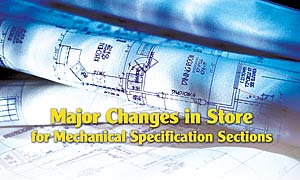
Issue: 1/04
Following their respective conventions in May, representatives of the American Institute of Architects (AIA) and the Construction Specifications Institute (CSI) continue to align Draft 4 of the proposed MasterFormat(TM) expansion with the interests of architects and constructors and with the next generation of AIA documents.
CSI is in the final stages of revisions to its industry standard publication, MasterFormat with input from the AIA and many other industry participants. The publication has undergone an expansion and some revisions that will make the document more user friendly. A task team was selected and has been working to expand and revise the document, while trying to maintain as much of the original format as possible. Task team members consulted with all types of users, created and distributed drafts, collected and evaluated commentary, and attempted to bring all of this information into line with the goals that were set to address the future of the construction industry. The document must equally address current needs and those of 40 years from now.
The task team started their work by creating a set of guiding principles based on needs expressed by users. The task team's progress from draft to draft has stayed on track by evaluating the commentary given by the industry at the various hearings that were held around North America. The comments from users have been addressed, and the task team has maintained a balance between meeting the needs of today and working to help implement a broader vision of an integrated electronic construction information marketplace that will soon be pervasive in the way we conduct our everyday work.
The expansion and revisions are in the fourth draft since this effort first began almost three years ago. Each draft has been published on the CSI Web site for industry review, and hearings have been held to get feedback from the industry. The task team's timeline and work plan for completion of these drafts has been extended from Dec. 2003 to the fall of 2004.
The various revisions have gone back and forth with how the mechanical and plumbing systems will be grouped. There were some mechanical contractors that wanted to have plumbing as a subsection of the Facility Services Subgroup of specification sections. The latest version has separate sections for mechanical and plumbing, but the sections are adjacent to each other. The task team has explored many possible options for maintaining this balance between the demands of the present and those of the near future, as well as the need that underlies it--to create the best, most flexible and forward-thinking expansion, and do so without taking this effort beyond the bounds of user acceptance. It would be senseless to create a master specification format that was not flexible or forward-thinking, and was thus ill-equipped to meet the challenges and needs of the future. It would also be pointless to create a master specification format that was so forward-thinking that it was unacceptable to today's users, and as a result, was not implemented.
In the latest proposal, the 16 divisions that have composed MasterFormat for its 40-year history have been expanded, both to encompass new subject matter and to allow room for additional expansion as needed in the future. The following principles established by the task team were the goals for this draft:
- 1. Maintain the same basic organization of Divisions 1-14.
2. Drop MasterFormat's product classification function, following OmniClass(TM) Construction Classification System (OCCS) principles.
3. Make MasterFormat more acceptable to building engineering disciplines.
4. Expand MasterFormat to cover other than building construction adequately.
5. Revise MasterFormat to follow classification principles where appropriate.
6. Provide space for expansion within each division by increasing from a five-digit to six-digit numbering system.
7. Maintain organizational consistency among divisions.
8. Expand the sections to have the capacity to comprehend the full life cycle, including use by owners and facility managers.

Division 00--Procurement and Contracting Requirements: Essentially the same scope as MasterFormat 95.
Division 01--General Requirements: Area for performance requirements added to allow for writing performance requirements for elements that overlap work sections (building envelope, structure, etc.). This allows for a mixture of broad performance specifications and prescriptive specifications in a project manual.
Division 02--Existing Conditions: This division is now limited to "existing conditions,"
New Division 21--Fire Suppression: Fire suppression subjects relocated from Division 13 in MasterFormat 95.
New Division 22--Plumbing: Plumbing subjects relocated from Division 15 in MasterFormat 95.
New Division 23--Heating, Ventilating and Air Conditioning: HVAC subjects relocated from Division 15 in MasterFormat 95.
New Division 25--Integrated Automation: Expanded integrated automation subjects relocated from Division 13 in MasterFormat 95.
New Division 26--Electrical: Electrical and lighting subjects relocated from Division 16 in MasterFormat 95.
New Division 27--Communications: Expanded communications subjects relocated from Division 16 in MasterFormat 95.
New Division 28--Electronic Safety and Security: Expanded electronic safety and security subjects relocated from Division 13 in MasterFormat 95.
New Site and Infrastructure Subgroup: This subgroup retains the basic scope of subject matter as published in the Civil and Utility Subgroup in Draft 4, but with site construction material moved to these divisions from Division 2 in MasterFormat 95 and some refinement in organization among the divisions.
New Division 31--Earthwork: Site construction subjects, chiefly below-grade, from Division 2 in MasterFormat 95.
New Division 32--Utilities: Expanded utility subjects relocated from Division 2 in MasterFormat 95.
New Division 33--Exterior Improvements: Site construction subjects, chiefly above-grade, from Division 2 in MasterFormat 95.
New Division 34--Transportation: Expanded transportation subjects relocated from various Divisions in MasterFormat 95.
New Division 35--Waterway and Marine: Expanded waterway and marine subjects relocated from mainly Division 2 in MasterFormat 95.
New Process Equipment Subgroup: This subgroup retains the basic scope of subject matter as published in Draft 4, with continued refinement in organization of the subjects among the divisions. Some material in this subgroup is new to MasterFormat 04, while some has been relocated form Divisions 11, 13, and 14 in MasterFormat 95.
New Division 41--Material Processing and Handling Equipment: Equipment for processing and conditioning of raw materials; material handling equipment for bulk materials, as well as discrete units; manufacturing equipment and machinery, test equipment, and packaging/shipping systems.
New Division 42--Process Heating, Cooling and Drying Equipment: Equipment for process heating, cooling and drying of materials, liquids, gases and manufactured items and materials.
New Division 43--Process Gas and Liquid Handling, Purification and Storage Equipment: Equipment for handling, purification and storage of process liquids, gases and slurries; includes atmospheric tanks as well as pressure vessels.
New Division 44--Pollution Control Equipment: Equipment for controlling emission of contaminants from manufacturing processes and treatment of air, water, soils and noise contaminants.
New Division 45--Industry-Specific Manufacturing Equipment: A division in which users can specify equipment that is used only within a single industry. All industries currently identified within the North American Industry Classification System (NAICS) are allocated space within the division.
New Division 46--Solid Waste Equipment: Plants and equipment for processing solid waste, this division is to be primarily used to specify equipment for wastewater treatment plants and the like.
New Division 48--Electrical Power Generation: Plants and equipment for the generation and control of electrical power from fossil fuel, nuclear energy, hydroelectric, wind, solar energy, geothermal energy, electrochemical energy and fuel cells.
The concept of expansion gaps between divisions has been retained from Draft 4, with reserved divisions that are not to be used spread through the whole document, and explicitly reserved to provide space for future development and expansion. To minimize costs resulting from potential future expansions, it's not recommended that users populate these divisions with their own material.
The MasterFormat Expansion Task Team's work also envisions the expanded content of MasterFormat serving to inform Table 22 (Work Results) of the OmniClass(TM) Construction Classification System (OCCS), a multi-table system for organizing information used by the AEC industry. The OCCS will be the basis for deriving relational applications, and will support and empower the transfer and use of information in the construction marketplace, ultimately serving all participants who work to sustain the built environment throughout the entire life-cycle.
Table 1 is a comparison of the specification sections in the existing 1995 MasterFormat specification sections and the proposed 2004 MasterFormat specification sections. (Editor's Note: Table 1 could not be reproduced online. Please see print edition for reference.) For a more detailed understanding of what the changes are and a summary of the changes to the four drafts, visit CSI's Web site at www.csinet.org.
